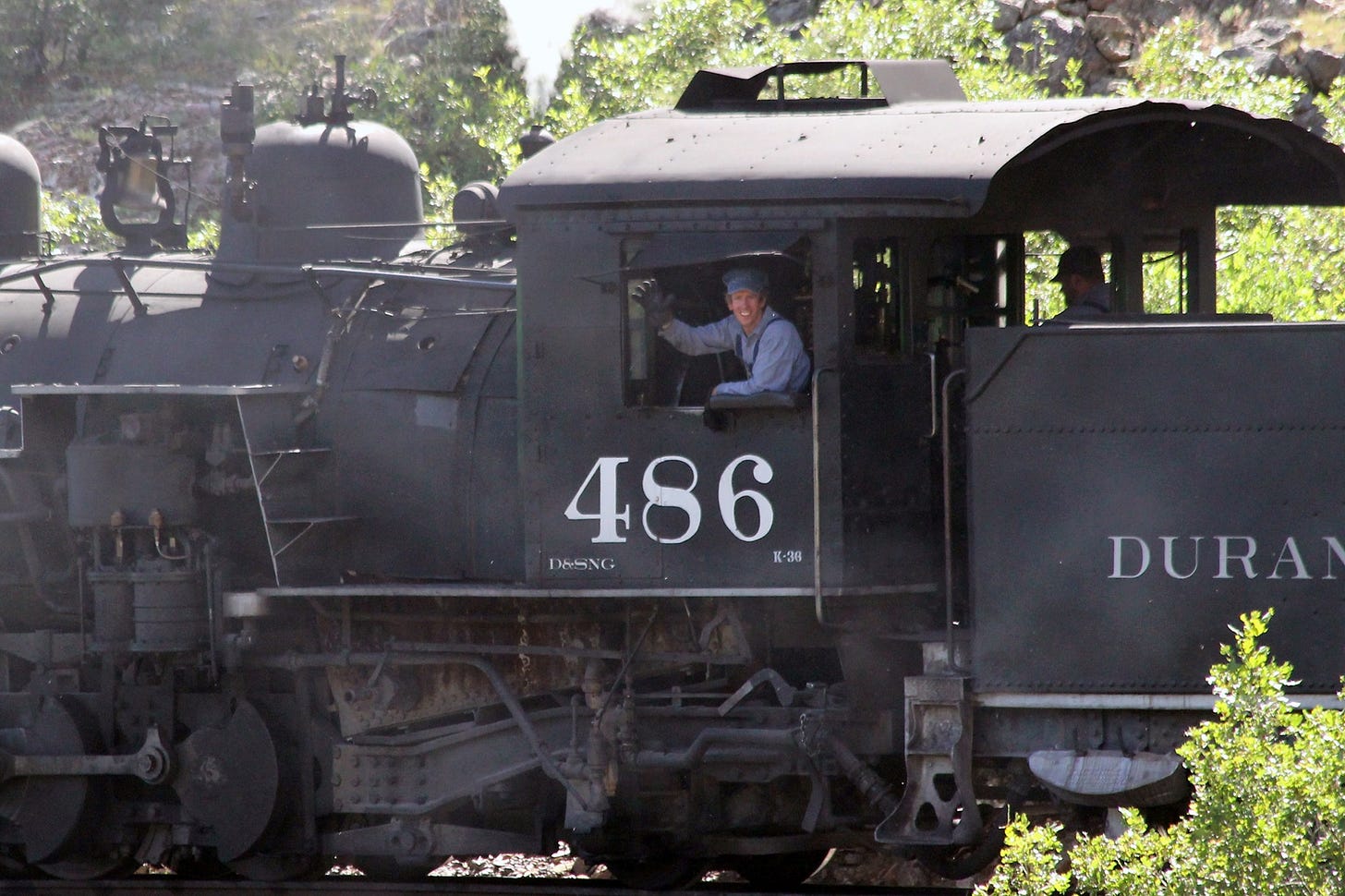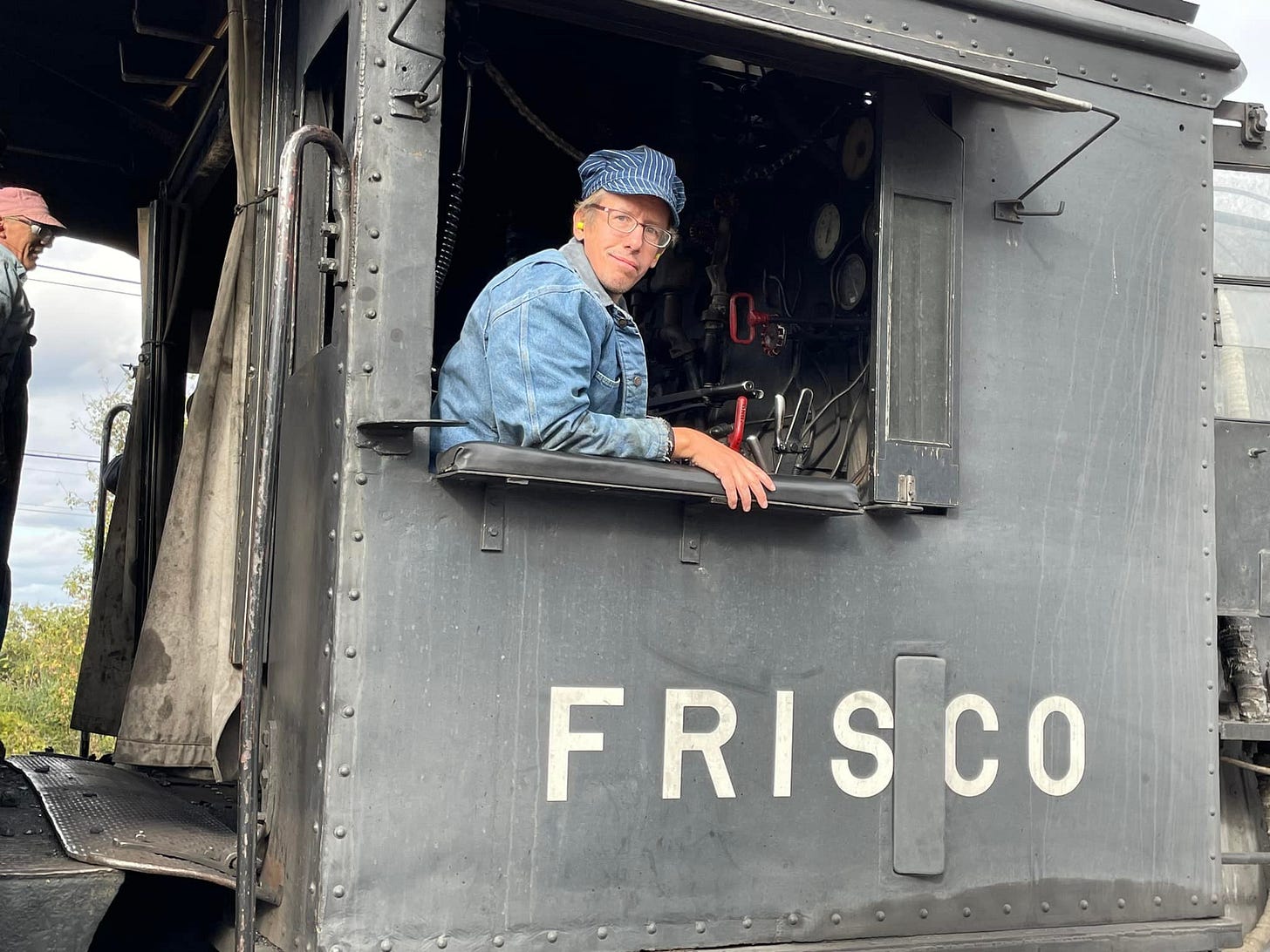Brian Davies - With a Smile
Behind the Throttle - Edition 2, Installment 1
“You can’t be away from (steam trains) for too long, you’ll miss it, it’s part of you.”

Restarting Behind the Throttle was motivated by a lot of things, but one of the most prevalent factors was my hope to spread positivity through the railroading industry. For our first feature of the second edition, we are excited to share the story of a railroader who always find a smile above steel rails, even against hard circumstances. For today’s feature, we are excited to introduce Brian Davies - With a Smile.
Brian was born in the midwest United States in the late 1970s to a family with no more than a passing interest in railroads. Though as a young child Brian always lit up when his parents would detour their route home to pass by the nearby Chicago Northwestern Mainline. In 1984, a National Geographic show called “Love Those Trains” further invigorated the budding interest in railroading. The show featured clips from railroads around the world, and the episodes featuring Colorado’s famous Durango and Silverton Narrow Gauge Railroad were always his favorites. Noting his fascination with trains, Brian’s dad and grandfather began to take him to the nearby Illinois Railway Museum for their special events, and later planned a family trip to Durango, Colorado, to see the railroad and the landscape that would glue Brian to a television for hours. Brian recalled that at 7 years old, he first set foot on the Durango and Silverton and had an “aha!” moment when he realized that the railroad he would obsess over back home was a real thing, still happening today. He has a vivid memory of his family’s first ride aboard the D&S, with locomotive 476 pulling his train. This engine would later become one of Brian’s favorite coworkers.

With father/son trips (often joined by his mother and his brother) to the IRM happening frequently, and the Davies family making the trek to Durango a yearly tradition, it’s no wonder that Brian’s interest in trains stuck around. As he got older, he itched to get involved in the behind-the-scenes work that kept his beloved railroads running, and the day after his 18th birthday (the first day he could volunteer on his own), Brian was at the Illinois Railway Museum, dawning a pair of clean overalls that would be stained black by lunchtime. Brian explained to me that he “dove head first into working on 1630”, the IRM’s large 2-10-0 steam locomotive. Given Brian’s skinnier build, head-first here is meant literally. His ambition and hunger for knowledge went a long way, and the time he began to dedicate (all with a big toothy smile on his face) did not go unnoticed. In 1996 Brian was given a chance to take up firing, his first taste of being a part of an engine crew. He took to the art of scoop quickly and marked up as a qualified fireman on his birthday of the same year, and quickly worked up to being an engineer in 1999. Brian would routinely find himself up at the museum for the next several years to come, spending his weekends with a group of volunteers that became his friends. He explained that every volunteer had a “I want to be here” type mindset, which was more than conducive to his education on steam locomotives. Similarly, the museum at that time had a group mindset of “We can get a lot done just by trying”, which often led the team of volunteers to succeed beyond what they though was actually capable. Brian was “passionate, or obsessed; whatever you want to call it”, he told me with a smile. His face was frequently dark with soot and grease, yet his smile brightened it up, earning him the nickname “Smiley” from some of the more senior folks he worked with.

In 2005, Brian felt the need for a big change and decided to try and make a childhood dream come true: Live in Durango and work for the railroad that lit off his passion. He hired on with the Maintenance-of-Way department, responsible for the upkeep of the track and monitoring line-side fires. His first summer season was spent pulling spikes and fighting fires, a new realm of railroad he was yet to experience but grateful to learn. The next year, he progressed to train operations too, and found himself working as a brakeman on the bucket-list train ride through the San Juan National Forest, sharing the railroad he loved with thousands of people and hoping to give them the same great experience that he had on his first trip at just seven years old. Though in 2007, Brian was involved in an accident working in maintenance-of-way, where his small speeder car used to patrol behind the trains was struck by a vehicle. This accident left Brian hurt physically, but also mentally. In need of some rejuvenation, he moved out to his parents’ new home in Florida and took a few years to recharge from trains.
While on hiatus from the world of steam, Brian worked with family on heavy machinery but felt the itch to railroad frequently. He explained to me that he was grateful for the time away because it showed him how important trains are to his sense of self: “You can’t be away from it for too long, you’ll miss it, it’s part of you.” Brian returned to the IRM to help retube the 1630 (the very task that got him started with the engine in the first place), to what felt like a homecoming. His fire was reignited, and he felt like himself again. He would return to Durango in 2019 as a fireman, manning both an oil throttle and a coal scoop for some time as he reacclimatized to railroading at an altitude. Without much warning, Brian was set on the roster of student engineers too, and found himself marking up as an engineer before long. From the engineer’s seat, Brian one day found himself looking down into the canyon at a scene that seemed familiar for some reason; he would then realize that the same angle was one of his favorite scenes in “Love Those Trains”, that he now got to view live-in-skin every day.
Nowadays, Brian splits his time between three areas: He works as a freelance legal transcriptionist during the winters at his family’s home in Florida, and spends his summers working as an engineer in Durango, all while sneaking back “home” to the Illinois Railway Museum in-between. On a personal note, I’ve been lucky enough to work crews with Brian during my own summer-stint on the Silverton, and found that he always brought a contagious smile with him to work, and made the days not only fun but worthwhile. Railroading, even in a tourist or a historic sense, is naturally a demanding job that involves uncomfortable environments and tough situations. Though through all that, Brian maintains gratitude for the work he does and executes each task with a calm demeanor and positive attitude. Brian mentioned that a brush with cancer in 2001 is a big reason for his level of gratitude as it proved to him that not every day is promised, nor do we always know the circumstances behind someone else’s life. Keeping these two things in mind, he approaches situations with respect for his coworkers and the public, and stays optimistic even when the days get long. Through every challenge is an opportunity to learn and grow, two of Brian’s favorite things to do.

Brian and I recounted some of his most favorite and formative memories from his long career with steam. He cited one of his first overnight experiences at the IRM when the 1630’s tubing was just finished, and he found himself with a small crew to take the engine for a test run under the moonlight. This was his first experience with a hot locomotive not surrounded by the large crowd of the public, and he felt a certain degree of peace among the calamity of the locomotive on its own. Later, in the same place, the 1630 was tasked with pulling a train of 135 coal hoppers that were being stored on the IRM mainline (car storage is a easy way for railroads to make passive income). Hoping to fire for the massive train (perhaps having missed his last day at the gym), Brian found himself as the only qualified engineer in the cab at the time of the move. With a few hundred eyeballs and camera aimed at him, he worked the engine just right and hauled the monstrous train along the IRM’s mainline to the interchange track with class-one railroad Union Pacific. He had never worked the engine so hard but felt the engine was happy with such a draft being pulled through the grates, and was thankful for a change to show off the power of a steam locomotive well past the golden days of railroading.
A unique chapter in Brian’s life was around the Christmas season in 2018, when an long-time friend and co-volunteer at the IRM invited Brian to assist in restoring the Lanaiha, Kaanapali and Pacific railroad, a tourist railroad on old sugar cane trackage in Hawaii. Bringing the railroad back to operation after several years of dormancy, his roles encompassed anything from trimming the 4-foot weeds along the right of way to rebricking the firebox of the locomotives and getting them into operational shape. Upon running the trains, Brian was tasked with training the crews - mostly locals to the area who had never seen a train before. Brian was taken aback by the immense gratitude and hospitality shown by the locals who made up the majority of their passengers: “Everyone thanked us for opening the railroad.” His short stay in Hawaii lasted only four months, but those four months were spent running trains, fixing things, and running trains again. Grateful for the experience, Brian recognizes that it probably won’t ever happen again, but hopes the folks from the area remember that chapter as fondly as he does.

Thinking towards the future, Brian hopes the industry that helped him define himself continues to welcome new blood in need of an identity. Further, he feels strongly that “everybody deserves a mentor”, and tries to share the knowledge that he’s gained through his career with anyone who asks: “When I die I want everyone to know everything I’ve learned.” Talking shop and sharing experiences of railroading remains one of his favorite things to do with his peers, capitalizing on the unspoken brotherhood of those who railroad. Though he hopes to never finds himself bragging, he will always share a good story and the lessons he learned from it. Proud of the track he’s taken, Brian will continue to smile as he sits behind the throttle: “This is right, this is where I should be”.

Thank you for reading our first installment in Edition 2 of Behind the Throttle, and thanks to Brian’s friends for sharing photos. From here on we’ll be publishing biweekly, so stay tuned for our next story on March 31st featuring Bethan Maher of the Mt. Rainier Scenic Railroad. Until then, I’m Max Harris, and I’ll see you down the line.

